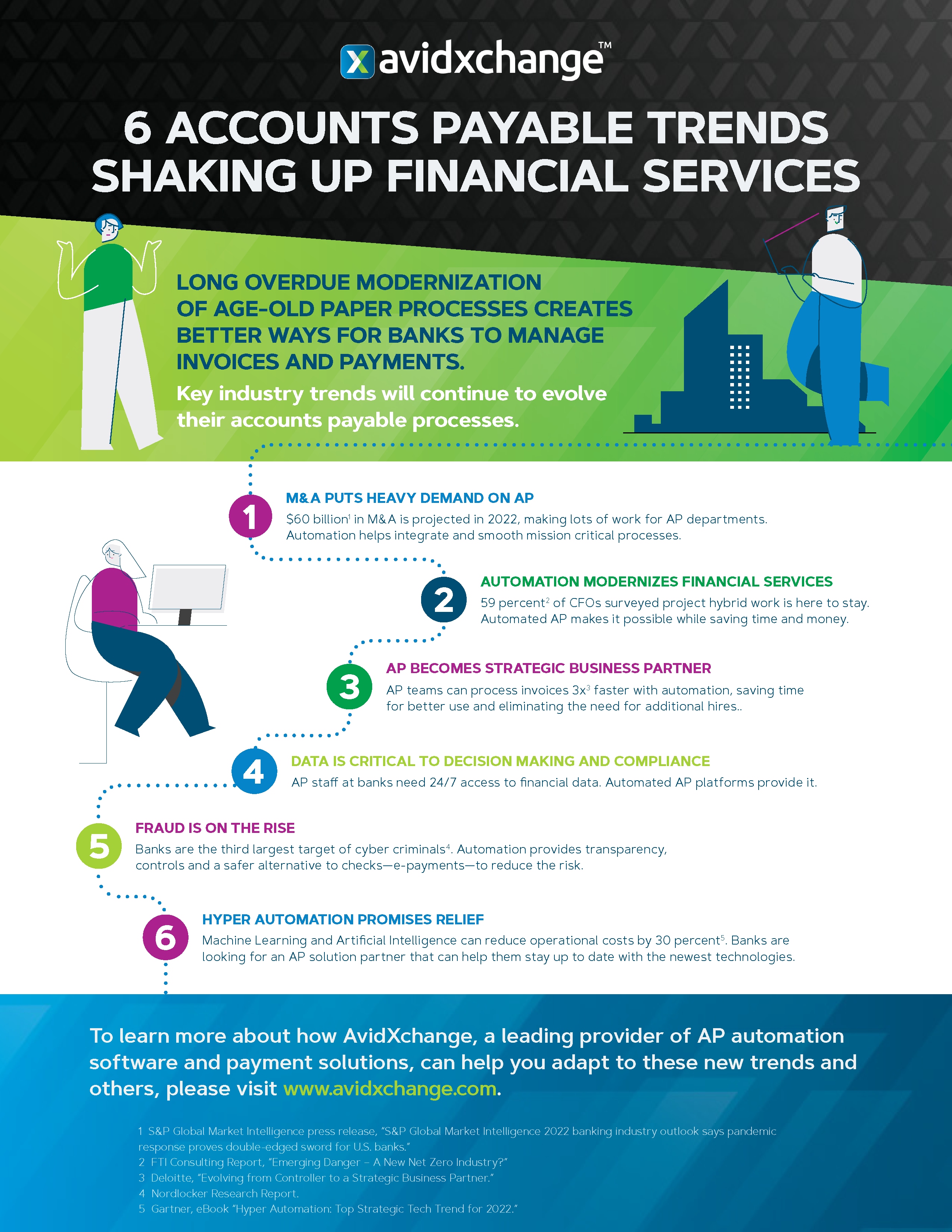Banks’ accounts payable (AP) departments are starting to look a lot different. The pandemic kick-started a long-overdue modernization of age-old paper processes, creating better ways for AP to work and evolve with its industry’s rapidly changing needs.
We’re taking a look at the current state of AP in banks and how key financial services industry trends are predicted to impact the way they manage their invoicing and payments to better serve their business in 2022 and beyond.

CLICK HERE TO DOWNLOAD THE INFOGRAPHIC
This handy guide outlines the six trends expected to impact the way the financial services industry manages its invoices and payments in 2022 and beyond.
1. M&A forcing banks to reconsider AP processes, seek support
Financial services was among the industries most impacted by corporate mergers and acquisitions in 2021. According to S&P Global Intelligence, there’s no slowdown in sight. In fact, $60 billion in deal activity is expected in 2022.
What does it mean for AP departments? A lot of work.
Banks are using different processes and providers to handle their AP. Swapping one for another isn’t always easy and merging them isn’t always possible. Banks that have automated their processes have a much easier time with it. They can rely on their solution providers to help smooth the transition and create a system that best works for the new organization.
But, not all automation providers can provide a stress-free merger process.
Oftentimes banks in the midst of a merger look to an automation provider to consolidate multiple products into one, easy-to-access solution. Cost savings is important to them, but time savings and efficiency are sometimes even more critical. They need a provider that has the technology and the expertise to make it happen.
Top 5 questions banks should ask AP automation providers when faced with a M&A
- Have you helped other banks through deals like ours?
- Can your product help us simplify work by doing the work of several processes and existing products?
- Which accounting systems do you integrate with, seamlessly?
- Do you have a roadmap that will support our growth and help us evolve with new technologies?
- Can you help us create new efficiencies for our department to save time and money?
As deal activity continues its steady pace in 2022, we’ll likely see AP departments at banks continue to lean heavily on their automation providers to help with transitions. If their provider falls short, they’ll be investing time in searching for a partner.
2. Continued shifts to hybrid work, modernized processes
Banks’ AP staff have been notoriously reluctant to change the way they’ve operated for decades, largely dependent on manual, paper-based processes to send and receive invoices and pay bills.
There hadn’t been heavy pressure on them to invest in new technologies, largely because they are not profit centers for their organizations. But, the laissez faire attitude about technology changed when the pandemic hit, forcing teams to work from home, unhinged from the paper and printers they relied on for handling important work.
As teams shifted to remote, and many now continue to work a hybrid of home and office, the advantages of modernization have become crystal clear. Not only did tech ensure the continuation of mission-critical processes without costly delays, it also revealed exciting opportunities.
Since 2020, many banks and credit unions have begun to more readily embrace modernization to reap its benefits. Some have taken baby steps, for instance automating invoice attachments or doing approvals online, and others have seized the competitive advantage by moving to complete end-to-end automation.
In 2022, as AP teams look to replace retiring workers and recruit new hires, it’s expected that incoming, younger generations will readily embrace, if not expect, automated AP solutions. Another factor that will likely influence adoption is the proliferation of banks looking to continue hybrid work environments, helping propel financial services into fully automated AP.
3. Onoging shifts to strategic, value-added work
As AP staff research new and better ways of working, there’s an important question on their minds: Will technology help cut costs and eliminate the need for additional spend?
There’s data that shows just how much automation can save them and how much time savings it provides. For instance, instead of taking weeks to receive, process and approve an invoice for payment, the work can be done in a matter of days.
By automating time-consuming processes, teams can take on more work — or better manage the work on their plates — without adding additional staff.
Those who have taken advantage of automation, can put their time to better use. Instead of chasing approvals or stuffing envelopes, staff can take on higher level work, leveraging newfound visibility to better analyze spend and more accurately budget and forecast for the future.
4. Leveraging data to provide visibility, ensure compliance
Organizations of all sizes are continually looking at ways to cut costs, drive efficiencies and take advantage of opportunities for growth. The responsibility for pulling the data they need to make important decisions often falls on AP.
AP staff at banks are continually inundated with requests for data, and yet questions like “why are my expenses up 25 percent this quarter?” are difficult to answer without reliant access to historical data and good reporting.
As pressure on banks increases and more departments are asking for data to manage budgets or to analyze trends, they’re looking to technology to help by offering them a platform with 24/7 access to data.
Being able to get the data you need, when you need it, and to use that data to analyze areas in question is invaluable. It saves AP teams countless hours and even days of their time, and makes their work more valuable to their organizations.
There’s another important reason data access is critical. Many of the requests AP fields — from the FDIC, the state, internal compliance departments, and slews of others — relate to audit procedures and compliance issues. The better access to data they have, the more easily, quickly, and accurately they can provide it to ensure ongoing compliance.
In 2022, it’s expected that firms look at purchasing and AP regulations training to help them avoid compliance issues and the costly penalties and lawsuits that can accompany them. They also look at technology to streamline the work, provide better visibility, and reduce the workload on their AP staff.
5. Growing awareness of cybersecurity threats, fraud
One of the biggest worries for banks is the potential for fraud. The threat is real and has been a driving force in automation.
Firms victimized by cybercrime often turn to automation, looking to do what they realize they should have already done. They may have had strict security structures in place, but lack policies because they have never been red-flagged on an audit. Some banks don’t realize they’ve been victimized until it comes up while onboarding an AP solution.
In 2022, firms will look to their automated AP solutions to help ward off threats by providing the transparency and controls banks need to keep a watchful eye on fraudulent threats. They can manage each vendor and protect sensitive information by putting controls in place to reduce the risk of fraud. Automation also enables banks to offer their vendors e-payments, a far safer payment method than paper checks.
6. Push toward hyperautmation
There’s chatter among AP teams regarding cutting-edge technologies like AI, robotics and machine learning. It’s for good reason. Gartner estimates the next-level technologies can reduce operational costs by 30 percent, saving organizations across industries both money and time.
In 2021, AP teams moved from Googling the catchphrases to calling their automation providers for insights and know-how.
Banks often reach out to their automation providers because their software hasn’t advanced with them and they’re wondering if new tech like AI can fill gaps and make their jobs easier. They want their providers to be smart about new trends and to help them evolve. The more expertise providers can provide, the more comfortable banks are to embrace new technology.
It’s likely that adoption of the new technologies will continue to advance as banks’ AP teams get more up to speed about the value they can bring to their work and their organizations. They’ll continue to rely on their AP automation providers to lead the way.



